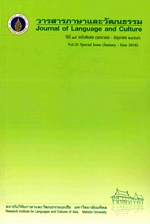Reawakening paper: New media and power
Main Article Content
Abstract
This article is from the attempt to channel the particular academic work to the public. Most of the article, research, or any literary productions typically are written in formal styles with particular theory, jargon language, and generally published by printing such as academic journals including books. Under such conditions, these turn to be two barriers for non-academic people who want to access to such valuable works. The first is the academic ways of writing which is hard to interpret for some academic outsiders. At the same time, they, secondly, could not easily reach to the work as most of the scholastical paper is not offered for sell in all over the place.
From the above mentioned, it shows that right and power of any knowledge consumers to freely approach to such work are being diminished. In this article, the writer will explore the hypotheses of media dimension in empirical detail as follows. Firstly, in order to make more clearly understanding, written language has been turned simply to spoken language by encodingdecoding theory under thought’s Hall and the theory of Uses and Gratification. Significantly, printing media has transformed through radio media to the public. More particularly, second, under the concept of the cultural flow on technoscapes and mediascapes of Arjun Appadurai which are in the mainstream in our modern world, this article additionally explains about each intellectual paper can be taken to listen through internet as frequently as needed. Therefore, the consequence is all research outcome can successfully be utilized everywhere.
In conclusion, however, this article would be emphasized the existence that general people are able to philosophically and concretely approach to what they want. In the similar way, it can be asserted that some difficult researches in printing media with specific writing patterns can be perceived uncomplicatedly and appeared freely to public in order possibly for some further developments in our society, if we use media wisely.
Article Details
The articles featured in the Journal of Language and Culture (JLC) constitute academic works representing the viewpoints of the respective author(s). It is crucial to note that these opinions do not necessarily reflect those of the Editorial Board.
All articles published in JLC are released under the Creative Commons Attribution 4.0 International License (CC BY 4.0). This license grants permission for unrestricted use, distribution, and reproduction in any medium, provided proper credit is given to the original author(s) and the source.
References
Appadurai, A. (1996). Modernity at Large: Cultural Dimensions of Globalization. Minnesota. The University of Minnesota Press. p.8-11, 31-36
Appadurai, A. (2001). Globalization. Durham & London. Duke University Press.
Baran, S. J. & Davis, D. K. (2006). Mass Communication Theory; Foundation, Ferment, and Future. (5thed.). Singapore. Wandsworth Cengage Learning.
Chuaychoowong, M. (2012). Reflective Journaling: How students learning can be enriched?. Conference Presentation. The European Conference Arts and Hummanities 2013, “Connectedness, Identity and Alenation” July 18-21, 2013.UK.
Colyar, J. (2009). Becoming writing, Becoming writer. Qualitative Inquiry. (Quoted in Thomas R. Lindlof & Bryan C. Taylor (2011). Qualitative Communication Research Methods (3rd ed.). London: SAGE Publications.
Encyclopaedia Britannica. (2009). Deluxe Edition.
Gunter, B. (2000). Media Research Methods: Measuring Audiences, Reactions and Impact. Retrieve from https://books.google.co.th/books?id=i5bHlhTUApQC&pg=PA292&lpg=PA292&dq=making+sense+of+the+news+Jenson+K.B.&source=bl&ots=4-Kg8 hgKpc&sig=cVCILeiDIGe_APdUv1 d9 EXWbTRU&hl=en&sa=X&ved=0 CCMQ6AEwA2oVChMIu6_R06aExgIVwzemCh2_NQDs#v=onepage&q=making%20sense%20of%20the%20news%20Jenson%20K.B.&f=false
Gunter, B. & Machin, D. (2009), (eds.). Media audiences. History of Audience Study, (Vol.1.). London et al.: Sage Publications (54-55).
Hall, S. (1980). Encoding and decoding.Retrieved from http://www.hu.mtu.edu/~jdslack/readings/CSReadings/Hall_Encoding-n-Decoding.pdf
Hall, S. (1980). Encoding and decoding in the television discourse. In S. Hall (ed),Culture, Media, Language. London: Hutchinson. Quoted in Baran, S. J. & Davis, D. K. (2009). Mass communication theory: Foundations, Ferment, and Future (5th ed). Boston: Wadsworth Cengage Learning. (p.245).
Johnson, S. & Ensslin, A. (2007). Language in the media. Representations, Identities, Ideologies. New York: Continuum International.
Kellner, D. (1995). Media culture: Cultural studies, identity and politics between the modern and the postmodern. New York. Routledge.
Lindlof, T. R. & Taylor, B. C. (2011). Qualitative communication research methods (3rded.). London. Sage Publications.
Matheson, D. (2005). Media discourses: Analysing media texts. Berkshire. Open University Press.
McLuhan, M. (1964). Understanding media: The extension of man. London et al.:Routledge. Retrieved from https://en.wikipedia.org/wiki/Marshall_McLuhan#Understanding_Media_.26183654>
McQuail, D. (2010). McQuail’s mass communication Theory. (6thed). London. Sage Publication.
McQuown, D. (2003). Radio: The chicago school of media theory. Retrieve from https://lucian.uchicago.edu/blogs/mediatheory/keywords/radio/.
Bhandarkar, P. L. & Wilkinson, T. S. (1999). Methodology and techniques of social research. New Delhi: Himalaya Publishing House.
Tracy, F. T. (1935). Radio and education. Retrieved from http://blogs.ubc.ca/etec540sept13/2013/10/27/762/
Walliam, N. (2006). Social Research Method. London. Sage Publications.p.192


